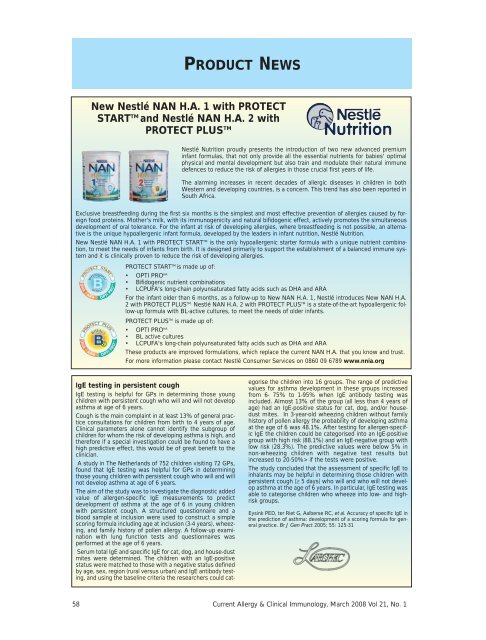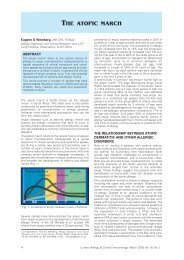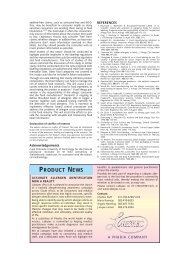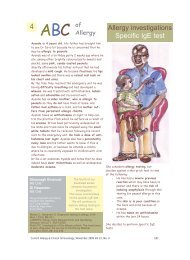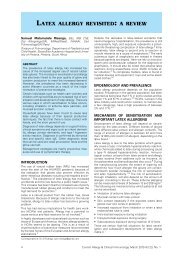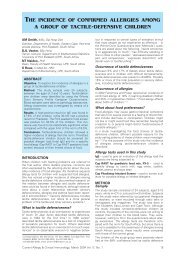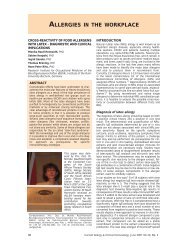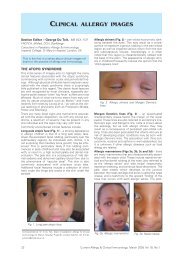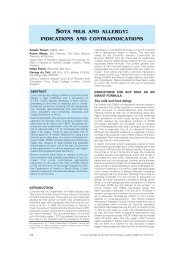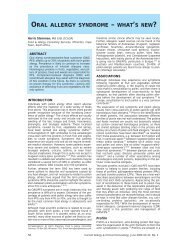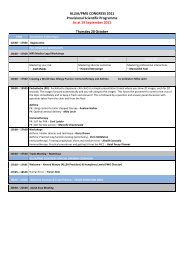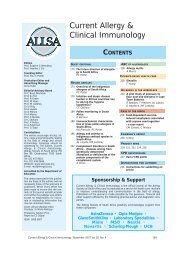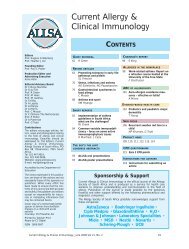Current Allergy and Clinical Immunology - March 2008
Current Allergy and Clinical Immunology - March 2008
Current Allergy and Clinical Immunology - March 2008
You also want an ePaper? Increase the reach of your titles
YUMPU automatically turns print PDFs into web optimized ePapers that Google loves.
PRODUCT NEWSNew Nestlé NAN H.A. 1 with PROTECTSTART TM <strong>and</strong> Nestlé NAN H.A. 2 withPROTECT PLUS TMNestlé Nutrition proudly presents the introduction of two new advanced premiuminfant formulas, that not only provide all the essential nutrients for babies' optimalphysical <strong>and</strong> mental development but also train <strong>and</strong> modulate their natural immunedefences to reduce the risk of allergies in those crucial first years of life.The alarming increases in recent decades of allergic diseases in children in bothWestern <strong>and</strong> developing countries, is a concern. This trend has also been reported inSouth Africa.Exclusive breastfeeding during the first six months is the simplest <strong>and</strong> most effective prevention of allergies caused by foreignfood proteins. Mother's milk, with its immunogenicity <strong>and</strong> natural bifidogenic effect, actively promotes the simultaneousdevelopment of oral tolerance. For the infant at risk of developing allergies, where breastfeeding is not possible, an alternativeis the unique hypoallergenic infant formula, developed by the leaders in infant nutrition, Nestlé Nutrition.New Nestlé NAN H.A. 1 with PROTECT START TM is the only hypoallergenic starter formula with a unique nutrient combination,to meet the needs of infants from birth. It is designed primarily to support the establishment of a balanced immune system<strong>and</strong> it is clinically proven to reduce the risk of developing allergies.PROTECT START TM is made up of:• OPTI PRO HA• Bifidogenic nutrient combinations• LCPUFA's long-chain polyunsaturated fatty acids such as DHA <strong>and</strong> ARAFor the infant older than 6 months, as a follow-up to New NAN H.A. 1, Nestlé introduces New NAN H.A.2 with PROTECT PLUS TM. Nestlé NAN H.A. 2 with PROTECT PLUS TM is a state-of-the-art hypoallergenic follow-upformula with BL-active cultures, to meet the needs of older infants.PROTECT PLUS TM is made up of:• OPTI PRO HA• BL active cultures• LCPUFA's long-chain polyunsaturated fatty acids such as DHA <strong>and</strong> ARAThese products are improved formulations, which replace the current NAN H.A. that you know <strong>and</strong> trust.For more information please contact Nestlé Consumer Services on 0860 09 6789 www.nnia.orgIgE testing in persistent coughIgE testing is helpful for GPs in determining those youngchildren with persistent cough who will <strong>and</strong> will not developasthma at age of 6 years.Cough is the main complaint in at least 13% of general practiceconsultations for children from birth to 4 years of age.<strong>Clinical</strong> parameters alone cannot identify the subgroup ofchildren for whom the risk of developing asthma is high, <strong>and</strong>therefore if a special investigation could be found to have ahigh predictive effect, this would be of great benefit to theclinician.A study in The Netherl<strong>and</strong>s of 752 children visiting 72 GPs,found that IgE testing was helpful for GPs in determiningthose young children with persistent cough who will <strong>and</strong> willnot develop asthma at age of 6 years.The aim of the study was to investigate the diagnostic addedvalue of allergen-specific IgE measurements to predictdevelopment of asthma at the age of 6 in young childrenwith persistent cough. A structured questionnaire <strong>and</strong> ablood sample at inclusion were used to construct a simplescoring formula including age at inclusion (3-4 years), wheezing,<strong>and</strong> family history of pollen allergy. A follow-up examinationwith lung function tests <strong>and</strong> questionnaires wasperformed at the age of 6 years.Serum total IgE <strong>and</strong> specific IgE for cat, dog, <strong>and</strong> house-dustmites were determined. The children with an IgE-positivestatus were matched to those with a negative status definedby age, sex, region (rural versus urban) <strong>and</strong> IgE antibody testing,<strong>and</strong> using the baseline criteria the researchers could categorisethe children into 16 groups. The range of predictivevalues for asthma development in these groups increasedfrom 6- 75% to 1-95% when IgE antibody testing wasincluded. Almost 13% of the group (all less than 4 years ofage) had an IgE-positive status for cat, dog, <strong>and</strong>/or housedustmites. In 3-year-old wheezing children without familyhistory of pollen allergy the probability of developing asthmaat the age of 6 was 48.1%. After testing for allergen-specificIgE the children could be categorised into an IgE-positivegroup with high risk (88.1%) <strong>and</strong> an IgE-negative group withlow risk (28.3%). The predictive values were below 5% innon-wheezing children with negative test results butincreased to 20-50%> if the tests were positive.The study concluded that the assessment of specific IgE toinhalants may be helpful in determining those children withpersistent cough (≥ 5 days) who will <strong>and</strong> who will not developasthma at the age of 6 years. In particular, IgE testing wasable to categorise children who wheeze into low- <strong>and</strong> highriskgroups.Eysink PED, ter Riet G, Aalberse RC, et al. Accuracy of specific IgE inthe prediction of asthma: development of a scoring formula for generalpractice. Br J Gen Pract 2005; 55: 125-3158 <strong>Current</strong> <strong>Allergy</strong> & <strong>Clinical</strong> <strong>Immunology</strong>, <strong>March</strong> <strong>2008</strong> Vol 21, No. 1


